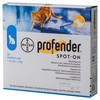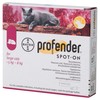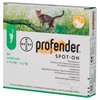Profender
Profender Spot-On Solution is indicated for cats suffering from, or at risk from, mixed parasitic infections caused by roundworms, tapeworms and lungworms.
Profender is presented as single use plastic pipettes with a clear yellow to brown solution for dermal (spot-on) application.
Profender Spot-On Solution for Medium Cats
£4.81Profender Spot-On Solution for Medium Cats is used to treat mixed parasitic infections caused by roundworms, tapeworms and lungworms in average breed cats weighing 2.5 - 5kg. Each 0.70ml...[More info]
Profender Spot-On Solution for Large Cats
£4.81Profender Spot-On Solution for Large Cats is used to treat mixed parasitic infections caused by roundworms, tapeworms and lungworms in larger breed cats weighing 5 - 8kg. Each 1.12 ml Tube...[More info]
Profender Spot-On Solution for Small Cats
£4.25Profender Spot-On Solution for Small Cats is used to treat mixed parasitic infections caused by roundworms, tapeworms and lungworms in smaller breed cats weighing 0.5 - 2.5kg. Each 0.35ml...[More info]
Use During Pregnancy and Lactation
Profender can be used during pregnancy and lactation.
Contra-indications, warnings, etc
Do not use in kittens under 8 weeks of age or weighing less than 0.5 kg.
Do not use in cases of hypersensitivity to the active substances or to any of the excipients.
Apply only to the skin surface and on intact skin. Do not administer orally or parenterally.
Avoid the treated cat or other cats in the household licking the site of application while it is wet.
Salivation and vomiting may occur in very rare cases. Mild and transient neurological disorders such as ataxia or tremor may occur in very rare cases. These effects are thought to occur as a result of the cat licking the application site immediately after treatment. In very rare cases following administration of Profender transient alopecia, pruritus and/or inflammation were observed at the application site.
The frequency of adverse reactions is defined using the following convention:
- very common (more than 1 in 10 animals treated displaying adverse reaction(s))
- common (more than 1 but less than 10 animals in 100 animals treated)
- uncommon (more than 1 but less than 10 animals in 1,000 animals treated)
- rare (more than 1 but less than 10 animals in 10,000 animals treated)
- very rare (less than 1 animal in 10,000 animals treated, including isolated reports).
Salivation, vomiting and neurological signs (tremor) were observed occasionally when the product was administered at up to 10 times the recommended dose in adult cats and up to 5 times the recommended dose in kittens. These symptoms were thought to occur as a result of the cat licking the application site. The symptoms were completely reversible. There is no known specific antidote.
Emodepside is a substrate for P-glycoprotein. Co-treatment with other drugs that are P-glycoprotein substrates/inhibitors (for example, ivermectin and other antiparasitic macrocyclic lactones, erythromycin, prednisolone and cyclosporine) could give rise to pharmacokinetic drug interactions. The potential clinical consequences of such interactions have not been investigated.
Shampooing or immersion of the animal in water directly after treatment may reduce the efficacy of the product. Treated animals therefore should not be bathed until the solution has dried.There is limited experience on the use of the product in sick and debilitated animals, thus the product should only be used based on a benefit-risk assessment for these animals.
Parasite resistance to any particular class of anthelmintic may develop following frequent, repeated use of an anthelmintic of that class.
The solvent in this product may stain certain materials including leather, fabrics, plastics and finished surfaces. Allow the application site to dry before permitting contact with such materials.
User Safety
Read the package insert before use.
Do not smoke, eat or drink during application.
Avoid direct contact with application area while it is wet. Keep children away from treated animals during that time.
Wash hands after use.
In case of accidental spillage onto skin, wash off immediately with soap and water.
If the product accidentally gets into eyes, they should be thoroughly flushed with plenty of water.
If skin or eye symptoms persist, or in case of accidental ingestion, seek medical advice and show the package insert or the label to the physician.
Care should be taken not to allow children to have prolonged intensive contact (for example, by sleeping) with treated cats during the first 24 hours after application of the product.
Further information
Pharmacotherapeutic group: therapeutic antiparasitic agent; ATCvet code: QP52AA51.
Emodepside is a semi-synthetic compound belonging to the new chemical group of depsipeptides. It is active against roundworms (ascarids and hookworms). In this product, emodepside is responsible for the efficacy against Toxocara cati, Toxascaris leonina, Ancylostoma tubaeforme, and Aelurostrongylus abstrusus.
It acts at the neuromuscular junction by stimulating presynaptic receptors belonging to the secretin receptor family which results in paralysis and death of the parasites.
Praziquantel is a pyrazinoisoquinoline derivative effective against tapeworms such as Dipylidium caninum, Echinococcus multilocularis, and Taenia taeniaeformis.
Praziquantel is rapidly absorbed via the surface of the parasites and acts primarily by changing the Ca++ permeability of the parasite membranes. This results in severe damage to the parasite integument, contraction and paralysis, disruption of metabolism and finally leads to the death of the parasite.
After topical application of this product to cats at the minimum therapeutic dose of 0.14 ml/kg bodyweight, mean maximum serum concentrations of 32.2 ± 23.9 µg emodepside/l and 61.3 ± 44.1 µg praziquantel/l were observed. Maximum concentrations were reached for emodepside 3.2 ± 2.7 days after application and 18.7 ± 47 hours for praziquantel. Both active substances are then slowly eliminated from the serum with a half-life of 9.2 ± 3.9 days for emodepside and 4.1 ± 1.5 days for praziquantel.
After oral application in the rat, emodepside is distributed to all organs. Highest concentration levels are found in the fat. Faecal excretion predominates with unchanged emodepside and hydroxylated derivatives as the major excretion products.
Studies in many different species show that praziquantel is rapidly metabolised in the liver. The main metabolites are monohydroxycyclohexyl derivatives of praziquantel. Renal elimination predominates.
Echinococcosis represents a hazard for humans. As Echinococcosis is a notifiable disease to the OIE, specific guidelines on the treatment and follow-up, and on the safeguard of persons, need to be obtained from the relevant competent authority.


